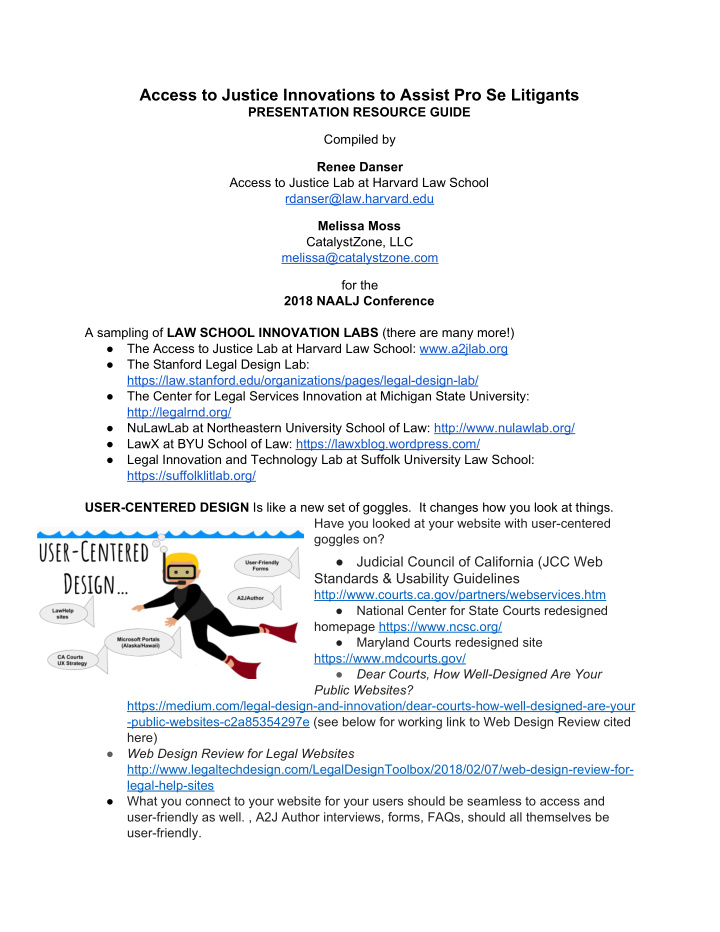



Access to Justice Innovations to Assist Pro Se Litigants PRESENTATION RESOURCE GUIDE Compiled by Renee Danser Access to Justice Lab at Harvard Law School rdanser@law.harvard.edu Melissa Moss CatalystZone, LLC melissa@catalystzone.com for the 2018 NAALJ Conference A sampling of LAW SCHOOL INNOVATION LABS (there are many more!) ● The Access to Justice Lab at Harvard Law School: www.a2jlab.org ● The Stanford Legal Design Lab: https://law.stanford.edu/organizations/pages/legal-design-lab/ ● The Center for Legal Services Innovation at Michigan State University: http://legalrnd.org/ ● NuLawLab at Northeastern University School of Law: http://www.nulawlab.org/ ● LawX at BYU School of Law: https://lawxblog.wordpress.com/ ● Legal Innovation and Technology Lab at Suffolk University Law School: https://suffolklitlab.org/ USER-CENTERED DESIGN Is like a new set of goggles. It changes how you look at things. Have you looked at your website with user-centered goggles on? ● Judicial Council of California (JCC Web Standards & Usability Guidelines http://www.courts.ca.gov/partners/webservices.htm ● National Center for State Courts redesigned homepage https://www.ncsc.org/ ● Maryland Courts redesigned site https://www.mdcourts.gov/ ● Dear Courts, How Well-Designed Are Your Public Websites? https://medium.com/legal-design-and-innovation/dear-courts-how-well-designed-are-your -public-websites-c2a85354297e (see below for working link to Web Design Review cited here) ● Web Design Review for Legal Websites http://www.legaltechdesign.com/LegalDesignToolbox/2018/02/07/web-design-review-for- legal-help-sites ● What you connect to your website for your users should be seamless to access and user-friendly as well. , A2J Author interviews, forms, FAQs, should all themselves be user-friendly.
INTERACTIVE FORMS & DOCUMENT ASSEMBLY : ● A2J Author: https://www.a2jauthor.org/ ● docassemble: https://docassemble.org/ LEGAL CLINICS can happen anywhere, including courthouses and local law or public libraries are easily accessible. ● Virtual Law Clinics Pikes Peak Public Library https://research.ppld.org/c.php?g=516916&p=3533556 ● Lawyers in the Library http://publiclibrariesonline.org/2018/03/lawyers-in-the-library ● Depending on your state’s rules they can help SRL’s complete forms or offer limited scope services. A state-by-state listing of self help/info resources/centers, unbundling rules and court forms can be found here: https://www.ncsc.org/topics/access-and-fairness/self-representation/state-links.aspx?cat =self+help+information+resources+and+centers ● In 2014 the ABA published the results of their national self help center survey https://www.americanbar.org/content/dam/aba/administrative/delivery_legal_services/ls_ del_self_help_center_census.authcheckdam.pdf ● Better Access though Unbundling: From Ideation to Implementation COURT NAVIGATORS, LIMITED LICENSE LEGAL TECHNICIANS AND SIMILAR PROGRAMS ● NYC Housing Court Navigator Program https://www.nycourts.gov/courts/nyc/housing/rap.shtml ● Roles Beyond Lawyers: Evaluation of the New York City Court Navigators Program https://www.srln.org/node/1320/roles-beyond-lawyers-evaluation-new-york-city-court-nav igators-program ● Colorado Self Represented Litigant Coordinators (known as Sherlocks) https://www.courts.state.co.us/Self_Help/information.cfm ● Washington Limited License Legal Technicians https://www.wsba.org/for-legal-professionals/join-the-legal-profession-in-wa/limited-licen se-legal-technicians ● Chief Justice Proposes Legal Wayfinders to Assist Litigants in California http://iaals.du.edu/blog/chief-justice-proposes-legal-wayfinders-assist-litigants-california
INTERACTIVE MAPPING ● Geographic Information System (GIS) technology and data can provide useful information to drive decision making in the justice community. Here are some resources that can help. h ttps://www.srln.org/GISDataResources ● Examples of SRLN’s GIS for Justice state-by-state mapping work including online story maps, interactive mapping applications, and static maps from a select number of states. https://www.srln.org/node/1297/maps-states ● For a national picture down to the county level, see America's Civil Courts: Whom Do We Serve? https://srln.maps.arcgis.com/apps/MapJournal/index.html?appid=7bed22dba4ec45f281b 766181b862156 ● Interactive maps from across the Census Bureau https://www.census.gov/geography/interactive-maps.html LEGAL TRIAGE ● Alaska and Hawaii Simplifying Legal Help Portal projects - LSC developed the vision for this portal working with leaders from across the access to justice community. Partners include The National Center for State Courts, Pro Bono Net, Microsoft and Avanade.. https://simplifyinglegalhelp.org/ https://www.lsc.gov/simplifying-legal-help ● Legal aid programs building triage tools https://medium.com/innovations-in-legal-aid/insights-on-online-intake-and-triage-52eb67 400638 ● What is Case Triage? Case triage is a more aggressive form of case management that involves the court staff and the litigants. By informing litigants early in the process of alternative tracks and processes, the litigant can make the choice as to which method to pursue before the case even begins. https://www.srln.org/node/552/weblink-national-center-state-courts-triage-page-ncsc-201 5
TRUSTED INTERMEDIARIES ● Recent Research shows 80% of individuals with legal issues never seek assistance any kind of professional assistance primarily because they do not know the problem they have might have a legal resolution. In order to get legal help to “the 80%”, consider reaching out to “trusted intermediaries” to create community gateways to legal information and services--through local domestic violence & homeless shelters, schools, churches, public libraries, healthcare and social service providers, etc. ○ Accessing Justice in the Contemporary USA (Rebecca Sandefur) http://www.americanbarfoundation.org/uploads/cms/documents/sandefur_accessi ng_justice_in_the_contemporary_usa._aug._2014.pdf ○ 2017 Justice Gap Report: Measuring the Civil Legal Needs of Low-income Americans https://www.lsc.gov/media-center/publications/2017-justice-gap-report ○ 2018 MacArthur Fellow Rebecca Sandefur, who advised LSC about its justice-gap survey, noted, “... we need to completely re-think our outreach strategies—to radically re-think how we connect people to services. ” https://harvardmagazine.com/2017/11/unequal-justice-america ● Trusted Help: The Role Of Community Workers As Trusted Intermediaries Who Help People With Legal Problems http://www.lawfoundation.on.ca/what-we-do/publications-research-and-evaluations/truste d-intermediaries-research BEFORE YOU INNOVATE Consider these four things. 1. Look at the processes you already have. Are they as simple, user-friendly and efficient as they could be? 2. Take a User Centered Design Approach in reviewing existing or new programs 3. Frame the right question and know what success will look like before you start 4. Does a systems or technological infrastructure already exist for you to piggyback on (like Law Help, or A2J Author) PROCESS IMPROVEMENT Everything you do is a step by step process. Every organization has multiple processes that, even if there are existing flowcharts and protocols, evolve over time--because, well, we’re human. Mapping out the processes you have, and who decides what and when, can yield some surprising results. It can also help you identify areas that are truly ripe for innovation as well help you get to the root cause of issues you have struggled with for years. Why is court process improvement/process simplification so important to your users? ● Trapped in Marriage, October, 2018 https://papers.ssrn.com/sol3/papers.cfm?abstract_id=3277900 ● and a description of the Harvard ATJLabs study here : http://a2jlab.org/current-projects/smaller-studies/divorce/
Recommend
More recommend